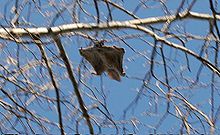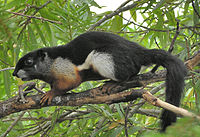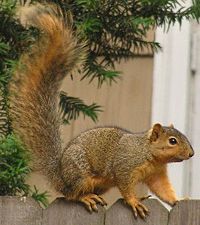- Northern flying squirrel
-
Northern Flying Squirrel 
Conservation status Scientific classification Kingdom: Animalia Phylum: Chordata Subphylum: Vertebrata Class: Mammalia Order: Rodentia Family: Sciuridae Genus: Glaucomys Species: G. sabrinus Binomial name Glaucomys sabrinus
(Shaw, 1801)The Northern flying squirrel (Glaucomys sabrinus) is one of two species of the genus Glaucomys, the only flying squirrels found in North America (the other is the somewhat smaller Southern flying squirrel, G. volans). Unlike most members of their family, flying squirrels are strictly nocturnal. The Northern flying squirrel is found in coniferous and mixed forests across the top of North America, from Alaska to Nova Scotia, south to North Carolina and west to California. Populations from the Pacific Coast of the United States are genetically distinct from those of G. sabrinus found elsewhere in North America, although they are considered to belong to the same species. Two subspecies are found in the southern Appalachians, the Carolina Northern flying squirrel, G. s. coloratus, and the Virginia Northern flying squirrel G. s. fuscus, both of which are endangered, although the Virginia subspecies has recovered enough that it has been delisted in August, 2008.[2] The U.S. Fish and Wildlife Service put the Flying Squirrel back under protection on June 6th, 2011.
Contents
Description
The nocturnal, arboreal rodents have thick light brown or cinnamon fur on their upper body. A furry membrane called a patagium extends between the front and rear leg and allows the animal to glide through the air. It's greyish on the flanks and whitish underneath. They have large eyes and a flat tail. They can also be identified by their long whiskers, common to nocturnal mammals. The adult northern flying squirrel measures from 25 to 37 cm long, and their weight can range from 110 to 230 grams.
Diet
A major food source for the squirrels are mushrooms fungi (truffles) of various species, although they also eat lichens, mushrooms, all mast-crop nuts, tree sap, insects, carrion, bird eggs and nestlings, buds and flowers. The squirrels are able to locate truffles by olfaction, though they also seem to use cues such as the presence of coarse woody debris, indicating a decaying log, and spatial memory of locations where truffles were found in the past.
The northern flying squirrel is also known to cache food for when food supplies are lower. These caches can be in cavities in trees, as well as in the squirrels' nest. Lichens and seeds are commonly cached.
Behavior
The Northern flying squirrel nests in holes in trees, preferring large-diameter trunks and dead trees, and will also build outside leaf nests called dreys. They sometimes use cavities created by woodpeckers. Suitable nest sites tend to be more abundant in old-growth forests, and so do the squirrels, though harvested forests can be managed in ways that are likely to increase squirrel numbers. Except when rearing young, the squirrels shift from nest to nest frequently. They often share nests. In one nest, over 50 individuals were found co-habitating, although usually nests contain 2-5 individuals. The sharing of nests by flying squirrels is important in maintaining body temperature in the winter, as flying squirrels do not hibernate. In the winter, northern flying squirrels tend to live in conifer areas of mixed woods, while in summer they are found in conifers and deciduous areas. This behaviour is associated with the belief that the canopy cover is important in protecting the squirrels from predation and colder temperatures. In all but the most severe weather conditions, the squirrels are active year-round.[citation needed]
Home ranges are up to 40,000 square metres for females and 50 percent higher for males.[citation needed]
Northern flying squirrel gliding distances tend to be between 5 and 25 meters, though glides of up to 45 m and longer have been observed. Average glides are about 5 m less for females than for males. Glide angle has been measured at 26.8 degrees and glide ratio at 1.98., width is 4 ft.
When the flying squirrel lands after a glide, it often will move sideways to the opposite side of the tree to escape potential predators that may be in pursuit.[citation needed]
In the Pacific northwest, the squirrels breed once per year, in May or June. In southern Ontario, polyestrus behavior has been documented.
Predation
Northern flying squirrels, along with pine squirrels, are an important prey species for the Spotted Owl Strix occidentalis. They also disseminate spores of the ectomycorrhizal fungi that they eat, and these are essential to many species of conifer and some deciduous trees. Other predators include various other owls, especially the Great Horned Owl, hawks, the American Marten, the Canadian Lynx and the Red Fox.
References
- ^ Linzey, A. V. & NatureServe (Hammerson, G. (2008). Glaucomys sabrinus. In: IUCN 2008. IUCN Red List of Threatened Species. Downloaded on 6 January 2009.
- ^ USFWS Delisting Report dated 8/09
- Arbogast, B. S. (1999). Mitochondrial DNA phylogeography of the New World flying squirrels Glaucomys: implications for Pleistocene biogeography. Journal of Mammalogy, 80, 142-155.
- Arbogast, B. S., Browne, R. A., Weigl, P. D. and Kenagy, G. J. (2005). Conservation genetics of endangered flying squirrels from the Appalachian mountains of eastern North America. Animal Conservation, 8, 123-133.
- Bakker, V. J., & Hastings, K. (2002). Den trees used by northern flying squirrels (Glaucomys sabrinus) in southeastern Alaska. Canadian Journal of Zoology, 80, 1623-1633.
- Carey, A. B., Kershner, J., Biswell, B., & De Toledo, L. D. (1999). Ecological scale and forest development: squirrels, dietary fungi, and vascular plants in managed and unmanaged forests. Wildlife Monographs 5-71.
- Carey, A. B., Wilson, T. M., Maguire, C. C., & Biswell, B. L. (1997). Dens of northern flying squirrels in the Pacific northwest. Journal of Wildlife Management, 61, 684-699.
- Cotton, C. L., & Parker, K. L. (2000). Winter activity patterns of northern flying squirrels in sub-boreal forests. Canadian Journal of Zoology, 78, 1896-1901.
- Forsman, E. D., Otto, I. A., Aubuchon, D., Lewis, J. C., Sovern, S. G., Maurice, K. J., & Kaminski, T. (1994). Reproductive chronology of the northern flying squirrel on the Olympic peninsula, Washington. Northwest Science, 68, 273-276.
- Martin, K. J., & Anthony, R. G. (1999). Movements of northern flying squirrels in different-aged forest stands of western Oregon. Journal of Wildlife Management, 63, 291-297.
- Mitchell, D. (2001). Spring and fall diet of the endangered West Virginia northern flying squirrel (Glaucomys sabrinus fuscus). American Midland Naturalist, 146, 439-443.
- Pyare, S., & Longland, W. S. (2001). Mechanisms of truffle detection by northern flying squirrels. Canadian Journal of Zoology, 79, 1007-1015.
- Pyare, S., Smith, W. P., Nicholls, J. V., & Cook, J. A. (2002). Diets of northern flying squirrels, Glaucomys sabrinus, in southeast Alaska. Canadian Field Naturalist, 116, 98-103.
- Odom, R.H., W.M. Ford, J.W. Edwards, C.W. Stihler, and J.M. Menzel. 2001. Developing a habitat model for the endangered Virginia northern flying squirrel (Glaucomys sabrinus fuscus) in the Allegheny Mountains of West Virginia. Biological Conservation 99: 245-252.
- Vernes, K. (2001). Gliding performance of the northern flying squirrel (Glaucomys sabrinus) in mature mixed forest of eastern Canada. Journal of Mammalogy, 82, 1026-1033.
External links
Categories:- IUCN Red List least concern species
- Flying squirrels
- Mammals of the United States
- Mammals of Canada
- Fauna of the United States
Wikimedia Foundation. 2010.





